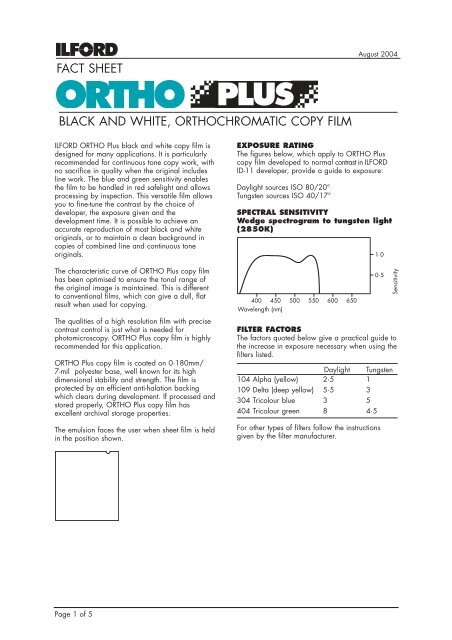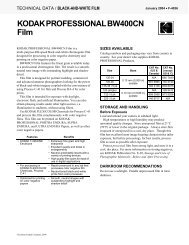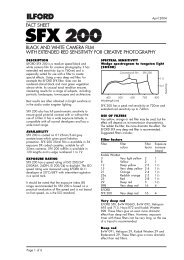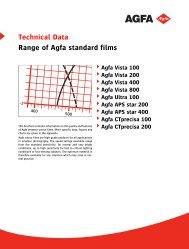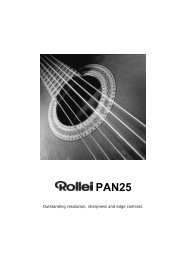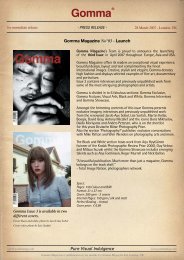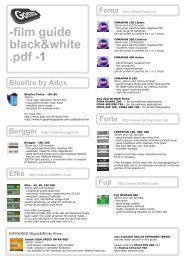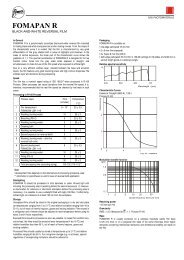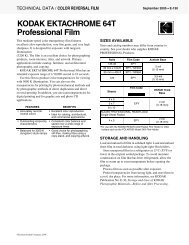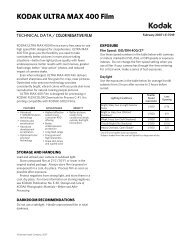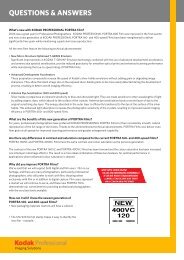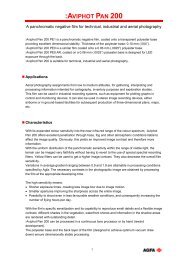Ilford Ortho plus - Gomma
Ilford Ortho plus - Gomma
Ilford Ortho plus - Gomma
Create successful ePaper yourself
Turn your PDF publications into a flip-book with our unique Google optimized e-Paper software.
FACT SHEET<br />
August 2004<br />
BLACK AND WHITE, ORTHOCHROMATIC COPY FILM<br />
ILFORD ORTHO Plus black and white copy film is<br />
designed for many applications. It is particularly<br />
recommended for continuous tone copy work, with<br />
no sacrifice in quality when the original includes<br />
line work. The blue and green sensitivity enables<br />
the film to be handled in red safelight and allows<br />
processing by inspection. This versatile film allows<br />
you to fine-tune the contrast by the choice of<br />
developer, the exposure given and the<br />
development time. It is possible to achieve an<br />
accurate reproduction of most black and white<br />
originals, or to maintain a clean background in<br />
copies of combined line and continuous tone<br />
originals.<br />
The characteristic curve of ORTHO Plus copy film<br />
has been optimised to ensure the tonal range of<br />
the original image is maintained. This is different<br />
to conventional films, which can give a dull, flat<br />
result when used for copying.<br />
The qualities of a high resolution film with precise<br />
contrast control is just what is needed for<br />
photomicroscopy. ORTHO Plus copy film is highly<br />
recommended for this application.<br />
ORTHO Plus copy film is coated on 0·180mm/<br />
7-mil polyester base, well known for its high<br />
dimensional stability and strength. The film is<br />
protected by an efficient anti-halation backing<br />
which clears during development. If processed and<br />
stored properly, ORTHO Plus copy film has<br />
excellent archival storage properties.<br />
The emulsion faces the user when sheet film is held<br />
in the position shown.<br />
EXPOSURE RATING<br />
The figures below, which apply to ORTHO Plus<br />
copy film developed to normal contrast in ILFORD<br />
ID-11 developer, provide a guide to exposure:<br />
Daylight sources ISO 80/20°<br />
Tungsten sources ISO 40/17°<br />
SPECTRAL SENSITIVITY<br />
Wedge spectrogram to tungsten light<br />
(2850K)<br />
Wavelength (nm)<br />
FILTER FACTORS<br />
The factors quoted below give a practical guide to<br />
the increase in exposure necessary when using the<br />
filters listed.<br />
Daylight Tungsten<br />
104 Alpha (yellow) 2·5 1<br />
109 Delta (deep yellow) 5·5 3<br />
304 Tricolour blue 3 5<br />
404 Tricolour green 8 4·5<br />
For other types of filters follow the instructions<br />
given by the filter manufacturer.<br />
Sensitivity<br />
Page 1 of 5
ORTHO Plus COPY FILM<br />
MAKING LONG EXPOSURES<br />
For exposures between 1/ 2 and 1 /10000 second, no<br />
corrections are needed for reciprocity law failure.<br />
When exposures longer than 1/ 2 second are given,<br />
ORTHO Plus copy film, along with other films,<br />
needs to be given more exposure than indicated<br />
by a meter. Use the graph to calculate the<br />
increased exposure time which should be given<br />
once the measured time is known.<br />
Adjusted exposure time (sec)<br />
Measured exposure time (sec)<br />
CHOOSING THE BEST ILFORD DEVELOPER FOR THE JOB<br />
This table gives development times in minutes for the stated contrast (G). Development times may be altered if a<br />
different contrast is needed.<br />
Pictorial contrast<br />
°C/ºF G0·62 to G0·70<br />
ID-11 stock 20/68 8 10<br />
ID-11 1+1 20/68 10 1/ 2 13<br />
ID-11 1+3 20/68 16 20<br />
MICROPHEN stock 20/68 9 12<br />
MICROPHEN 1+1 20/68 11 1/ 2 14 1/ 2<br />
MICROPHEN 1+3 20/68 13 1/ 2 17<br />
PERCEPTOL stock 20/68 13 16<br />
ILFOSOL S 1+9 20/68 4 1/ 2 6<br />
ILFOTEC HC 1+15 20/68 4 5<br />
ILFOTEC HC 1+31 20/68 6 8<br />
ILFOTEC DD stock 24/75 5 1/ 2 6 1/ 2<br />
ILFOTEC RT RAPID 1+1+2 26/79 65s 127s<br />
ILFOTEC RT RAPID 1+1+5 26/79 78s 153s<br />
Non-ILFORD developers<br />
G0·62 to G0·70<br />
Kodak D-76 stock 20/68 8 10<br />
Kodak D-76 1+1 20/68 10 1/ 2 13<br />
Kodak T-Max RS stock 24/75 3 1/ 2 4 1/ 2<br />
Kodak T-Max 1+4 20/68 5 6 1/ 2<br />
Intermediate contrast<br />
G0·80 to G1·00<br />
PQ UNIVERSAL 1+9 20/68 4 12<br />
High contrast<br />
G1·2 to G1·8<br />
PHENISOL 1+4 20/68 3 10<br />
Note For dish/tray development with continuous agitation, reduce these times by 15%.<br />
Page 2 of 5
ORTHO Plus COPY FILM<br />
PROCESSING AT DIFFERENT<br />
TEMPERATURES<br />
ORTHO Plus copy film can be processed over a<br />
range of temperatures. Development times at<br />
temperatures other than 20°C/68ºF may be<br />
calculated from the chart below.<br />
CHARACTERISTIC CURVES<br />
Pictorial contrast<br />
For example, if 4 minutes at 20°C/68ºF is<br />
recommended, the time at 23°C/73ºF will be 3<br />
minutes and the time at 16°C/61ºF will be 6<br />
minutes.<br />
Density<br />
Relative log exposure<br />
ORTHO Plus copy film developed in ILFORD ID-11<br />
(stock) for 8 minutes and 10 minutes at<br />
20ºC/68ºF with intermittent agitation.<br />
Temperature (ºC)<br />
Intermediate contrast<br />
3.0<br />
New development time (min)<br />
G1.00<br />
2.0<br />
G0.80<br />
1.0<br />
Density<br />
1 2 3 4<br />
Relative log exposure<br />
ORTHO Plus copy film developed in ILFORD PQ<br />
UNIVERSAL (1+9) for 4 minutes and 12 minutes,<br />
at 20°C/68ºF with intermittent agitation.<br />
Temperature (ºF)<br />
High Contrast<br />
New development time (min)<br />
Density<br />
Relative log exposure<br />
ORTHO Plus copy film developed in ILFORD<br />
PHENISOL (1+4) for 3 minutes and 10 minutes, at<br />
20°C/68ºF with intermittent agitation.<br />
Page 3 of 5
ORTHO Plus COPY FILM<br />
PROCESSING<br />
ORTHO Plus copy film can be processed in all<br />
types of processing equipment including rotary<br />
processors, dishes/trays, deep tanks and<br />
automatic processors. Standard capacity figures<br />
and replenishment rates can be maintained.<br />
Safelight recommendations<br />
Use an ILFORD 906 (dark red) safelight<br />
illuminated by a 15 watt bulb. As a precaution<br />
against fogging and hence reduced image<br />
contrast, a minimum distance of 1·2 m/4ft<br />
between the safelight and the working area is<br />
recommended. For best results, keep safelight<br />
exposure to a minimum.<br />
Agitation<br />
Intermittent agitation is recommended for use in<br />
deep tanks. Continuous agitation is recommended<br />
in dishes/trays by rocking the dish/tray.<br />
Otherwise, follow the recommendations given by<br />
the processing equipment manufacturer.<br />
Stop, fix, wash and rinse<br />
For best results it is recommended that all process<br />
solutions are kept at the same temperature or at<br />
least within 5ºC (9ºF) of the developer<br />
temperature.<br />
Stop Bath<br />
After development the film can be rinsed in water<br />
but we recommend that an acid stop bath is used<br />
such as ILFORD ILFOSTOP (with indicator dye) or<br />
ILFOSTOP PRO (without indicator dye). ILFOSTOP<br />
PRO is recommended for all machine processing<br />
applications. When tanks or dishes/trays of<br />
process solutions are in use a stop bath<br />
immediately stops development and reduces carry<br />
over of excess developer into the fixer bath. This<br />
helps to maintain the activity and prolong the life<br />
of the fixer solution.<br />
ILFORD Stop ILFOSTOP ILFOSTOP PRO<br />
Bath<br />
Dilution 1+19 1+19<br />
Temperature 18–24ºC 18–24ºC<br />
range (64–75ºF) (64–75ºF)<br />
Time (seconds)<br />
at 20ºC (68ºF)<br />
10 10<br />
Capacity 15 x 22 x<br />
films/litre 120.3x25.4cm 20.3x25.4cm<br />
(unreplenished) (8x10in) (8x10in)<br />
The process time given is the minimum required, if<br />
necessary a longer time may be used and should<br />
not cause any process problems provided it is not<br />
excessive.<br />
Fix<br />
The recommended fixers are ILFORD RAPID FIXER<br />
and ILFORD HYPAM liquid fixers and ILFORD<br />
ILFOFIX II powder fixer,all are non-hardening<br />
fixers.<br />
ILFORD Fixer ILFORD HYPAM & ILFORD<br />
ILFORD RAPID FIXER ILFOFIX II<br />
Dilution 1+4 stock<br />
Temperature 18–24ºC 18–24ºC<br />
range (64–75ºF) (64–75ºF)<br />
Time (mins)<br />
2–5 4–8<br />
at 20ºC (68ºF)<br />
Capacity 24 x 24 x<br />
films/litre 20.3x25.4cm 20.3x25.4cm<br />
(unreplenished) (8x10in) (8x10in)<br />
WASH<br />
When a non-hardening fixer has been used wash<br />
the films in running water for 5–10 minutes at a<br />
temperature within 5ºC (9ºF) of the process<br />
temperature.<br />
Rinse<br />
For a final rinse use ILFORD ILFOTOL wetting<br />
agent added to water, it helps the film to dry<br />
rapidly and evenly. Start by using 5ml per litre of<br />
rinse water (1+200), however the amount of<br />
ILFOTOL used may need some adjustment<br />
depending on the local water quality and drying<br />
method. Too little or too much wetting agent can<br />
lead to uneven drying. Remove excess rinse<br />
solution from the film before drying.<br />
Page 4 of 5
ORTHO Plus COPY FILM<br />
FIX HARDENER<br />
ILFORD RAPID FIXER and ILFORD ILFOFIX II must<br />
not be used with fix hardeners as they are not<br />
compatible with them. If a fix hardener is required<br />
then only ILFORD HYPAM fixer can be used. Add<br />
ILFORD HYPAM HARDENER to turn HYPAM into a<br />
hardening fixer.<br />
Generally for most applications modern camera<br />
films are sufficiently hardened at manufacture.<br />
Additional hardening from a fixer hardener is not<br />
usually needed or recommended for processing in<br />
spiral tanks, dishes/trays, deep tanks, rotary<br />
processors, dip and dunk (hanger) machines and<br />
short leader card processors, unless the processing<br />
temperature is above 30ºC (86ºF), or poor drying<br />
performance is being experienced. To minimise<br />
the risk of physical damage a fixer hardener may<br />
be needed when using a roller transport film<br />
processor.<br />
Using a fix hardener will require the<br />
recommended fix and wash times to be extended.<br />
Depending on the film and processing conditions<br />
the hardened fix time will be between 4 and 10<br />
minutes and the subsequent wash time 10–20<br />
minutes in running water.<br />
Drying<br />
Dry ORTHO Plus copy film at 30–40°C/<br />
86–104ºF in a drying cabinet or at room<br />
temperature in a clean dust-free area.<br />
Storage<br />
Store ORTHO Plus copy film in a cool<br />
(10–20°C/50-68ºF), dry place in its original<br />
packaging.<br />
Exposed film<br />
As with any film, once exposed, process ORTHO<br />
Plus copy film as soon as possible. Images on<br />
exposed but unprocessed film will not degrade<br />
during normal working periods, that is, up to one<br />
month when stored as recommended.<br />
Negatives<br />
Store processed negatives in a cool (10–20°C/<br />
50–68ºF), dry place, in the dark. Suitable storage<br />
sleeves include those made of cellulose triacetate,<br />
Mylar or paper (pH 6·5–7·5) or inert polyester.<br />
A wide range of fact sheets is available which describe and<br />
give guidance on using ILFORD products. Some products in<br />
this fact sheet might not be available in your country.<br />
The amount of HYPAM HARDENER that can be<br />
added to the fixer is dependant on the film and<br />
process conditions used. In some processors the<br />
full amount of hardener cannot be used as the fix<br />
and wash times cannot be extended adequately.<br />
In these circumstances we recommend starting with<br />
the minimum amount of hardener to have some<br />
effect. This is around 3–6mls of hardener per litre<br />
of working strength HYPAM used. This increases<br />
the film hardness slightly but has a negligible<br />
effect on the fix and wash efficiency. When fix<br />
and wash times are restricted the maximum<br />
amount of HYPAM HARDENER recommended is<br />
10–20ml of hardener per litre of working strength<br />
HYPAM used. This higher amount gives a definite<br />
increase to the hardness of the films processed<br />
and while fixing and washing efficiency are<br />
reduced the films will be adequately fixed and<br />
washed for most purposes.<br />
When fix and wash times can be extended the<br />
maximum amount of HYPAM HARDENER needed<br />
to achieve fully hardened films is 1 part to 40<br />
parts working strength HYPAM i.e. 24 ml per litre.<br />
ILFORD Imaging UK Limited, Town Lane, Mobberley<br />
Knutsford, Cheshire WA16 7JL, England<br />
www.ilford.com<br />
Page 5 of 5<br />
95056.GB.www August 2004


